Taekkyeon
Taekkyon, Taekgyeon, Taekkyeon, or Taekyun (Korean: 태껸/ 택견, pronunciation: tʰɛk̚k̕yʌn) is a traditional Korean martial art.
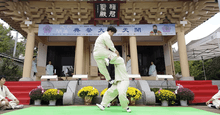 Taekkyon Demonstration on National Foundation Day 2017 at Sajikdan, Seoul | |
| Also known as | Taekgyeon, Taekkyeon |
|---|---|
| Focus | Self-defense with a focus on kicks, trips, throws in competitions |
| Hardness | Full contact |
| Country of origin | |
| Parenthood | Subak |
| Official website | Four associations |
| Taekkyeon | |
|---|---|
| Popular spelling | |
| Hangul | |
|---|---|
| Revised Romanization | Taekgyeon |
| McCune–Reischauer | T'aekkyŏn |
| IPA | tʰɛk̚k̕yʌn |
| Dictionary spelling | |
| Hangul | |
| Revised Romanization | Taekkyeon |
| McCune–Reischauer | T'aekkyŏn |
It is characterized by fluid, dynamic foot movement called "pum balgi" or Stepping-on-Triangles. Taekkyon is concerned with applying both the hands and feet at the same time to unbalance, trip, or throw the opponent. Hands and feet are always used together. Taekkyon has many leg and whole-body techniques with fully integrated armwork. A Taekkyon practitioner is called a "Taekkyon-kkun" (태껸꾼) and wears a uniform called "dobok".
In the twentieth century, Taekkyon has come to be seen as a living link to Korea's past. As such, it has provided historical references for modern Korean martial arts and is often considered as the oldest martial discipline of Korea.[1]
Taekkyon is the first martial art recognised as a National treasure of South Korea (1983)[2][1] and a UNESCO Intangible Cultural Heritage (2011).[3]
History of Taekkyon
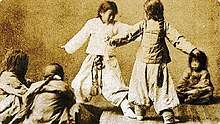
Historical records regarding Taekkyon are scant and ambiguous. The term is described as a Martial art -probably descended from earlier dynasties' Subak- or as a folk game. The earliest written source of the term appears during the Joseon Dynasty, in the book Jaemulbo (also Manmulbo), written by Lee Sung-Ji during the reign of King Jeongjo (1776–1800):[4]
- "Byeon and Subak are Byeon, Gangnyeok is Mu and all these are called Tak-gyeon" (卞 手搏爲卞 角力爲武 苦今之탁견).
The word is written in Hangul, which denotes its connection with the common people while the other terms are written in hanja.
Song Deok-gi (1893–1987) who was the main preserver of Taekkyon during the 20th century, writes in the preface of his only book : "It cannot be said for sure when and how Taekkyon came into existence, but until the end of the Korean kingdom, certain people did Taekkyon together."[5]
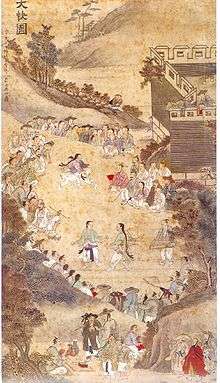
Taekkyon is documented for the first time in the West as a living martial art by renowned anthropologist Stewart Culin in his book "Korean Games" (1895).[6] In the book "Haedong Jukji" (East Sea Annals) by Choe Yeong-nyeon (최영년) from 1921, Taekkyon is lyrically called "flying leg technique" (bi-gak-sul, 비각술, 飛脚術).[7][8]
Taekkyon was widely practised during the Joseon period. Two versions existed at the time: one for combat application, the other as a game, very popular among plebs alongside Ssireum. Both combat sports were often done together at festivals, attended by all social classes. For example, during the Dano-Festival, a tournament called Gyeollyeon (결련) was carried out. Players who beat five opponents consecutively could take a rest and re-enter the tournament again later.[9]
Nonetheless, Taekkyon's popularity suffered a lot as Neo-Confucianism became widespread among the elite and underwent a long period of decline. At the dawn of the 20th century, it was only practised around the capital city of Hanyang (Seoul), in the district of Jongro. The subsequent Japanese occupation (1910-1945) prohibited indigenous fighting techniques which nearly made the art extinct.[10]
The onslaught of the subsequent Korean War (1950-1953) left only one surviving Master: Song Deok-gi. Being part of the last generation who received a traditional education, he had maintained his practice in secret throughout the Japanese occupation and subsequently laid the seeds for the art's regeneration. The style he practiced was called Widae (High-village) after his village of Sajik, Jongro district. Song was critical in the preservation of Taekkyon, since most of our actual knowledge comes from him. Revealed to the public on 26 March 1958 after a Martial arts demonstration given for then president Syngman Rhee's birthday, Song became known as "the Last Taekkyon Master of the Joseon Dynasty".
He taught a handful of students who in turn transmitted the art. On June 1, 1983, Taekkyon was given the classification as Important Intangible Cultural Asset No. 76" by the Korean government (중요무형문화재 제76호). It is only one of two Korean martial arts which possesses such a classification. Song Deok-gi was subsequently given living national treasure status by the South Korean government.[11] Since then, Taekkyon has been enjoying a renaissance with the establishment of university clubs, the opening of new schools and active promotional efforts from the government and associations alike. On June 30, 1985, the first Taekkyon tournament since 70 years[12] was held in Busan.
Song Deok-Gi died on 23 July 1987, at the age of 94. In November 2011, Taekkyon was recognized by UNESCO and placed on its Intangible Cultural Heritage List,[13] being honored as the first martial art on UNESCO's list, the other being Ssireum.[14]
Techniques
Taekkyon utilizes a wide variety of techniques including kicks, fist, knee and elbow strikes, pressure point attacks, throws, joint locks, head butt and grapples.[15] The whole body is used in each movement. The most unique feature of Taekkyon is its triangular foot work called pumbalkki (품밟기) which looks like a dance. The meaning of pumbalkki is "to step the pum". Pum refers to the triangular look of the hanja 品, as pumbalkki has a triangular form as well. The hanja pum means "level" or "goods", but it is used only because of its shape, not because of its meaning.Modern Taekkyon schools teach a great variety of kicks, low, medium, and high, as well as jumps. Sweeps with straight forward low kicks using the ball of the foot and the heel and flowing crescent-like high kicks. There are many kicks that move the leg outward from the middle, which is called gyeot chagi, and inward from the outside using the side of the heels and the side of the feet. The art also uses tricks like inward trips, wall-jumping, fake-outs, tempo, and slide-stepping. The basic steps are geometric and at the core of all advanced movement. All movements are natural to the human body.
The movements of Taekkyon are fluid with the practitioners constantly moving. One of its most striking characteristics is the motion called gumsil or ogeum jil: It is a constant bending and stretching of one's knees, giving the art a dance-like appearance. This motion is also used in the Korea mask dance talchum, so both arts look similar in a way: the art is like a dance in which the fighter constantly changes stance from left to right by stepping forward and backwards with arms up and ready to guard, blending arm movements with leg. Taekkyon does not make use of abrupt knee motions. The principles and methods used to extend the kick put more emphasis on grace and alignment for whole-body strength, as with the arm motions.
Although Taekkyon primarily utilizes kicking, punching, and arm strikes thrown from a mobile stance and does not provide a framework for groundfighting, it does incorporate a variety of different throws, takedowns, and grappling techniques to complement its striking focus.
There are evolving forms in Taekkyon. One form can be performed many different ways with its variations over the basic ten-year training period. The curriculum is adjustable within the traditional system. Masters may create their own personalized approach for teaching the basic Taekkyon system.
As a competitive martial art / competition
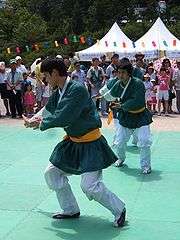
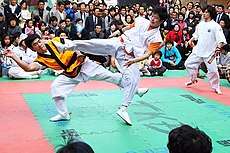
When Taekkyon is practiced in competition, it uses a limited subset of techniques, focusing on grappling and kicking only. Points are scored by throwing (or tripping) the opponent to the ground, pushing them out of the ring, or kicking them in the head. There are no hand strikes or headbutts, and purposefully injuring your opponent is prohibited. The head kicks are often quite sharp, but usually not full force, and fighters may not attempt to wear the opponent down with body blows as in western Boxing or Muay Thai. Matches are sometimes decided by the best of three falls—the first fighter to score two points wins. However, different modern associations employ slightly different rules. To an untrained eye, the matches are cautious but exhilarating affairs. The contestants circle each other warily, changing their footwork constantly using pumbalkki and feinting with low kicks, before exploding into a flurry of action which might leave one fighter flat on their back.
Modern development
Various Taekkyon organisations currently exist in Korea. These include:
- The Widae Taekkyon Preservation Society, also called World Widae Taekkyon Organization (WWTO). Based in Seoul and Los Angeles. Led by Lee Jun-seo and Ko Yong-Woo, the two most senior students of Song Deok-gi.[16] This association was established by Song Deok-gi and Lee Jun-seo in 1983.
- The Korea Traditional Taekgyeon Association (KTTA). Based in Chungju. The KTTA is led by Jeong Kyung-hwa who was given the title of "living cultural asset of the second generation" by the Korean Government in 1995. He was the main pupil of Shin Han-seung. The KTTA was responsible for the recognition of Taekkyon as an Intangible Cultural Heritage of Humanity.[17]
- The Korea Taekkyon Federation (KTF). Based in Busan, established in 1991. The KTF is led by Lee Yongbok. Originally an 8th Dan in Taekwondo, he mainly learnt Taekkyon as an autodidact with a brief stint under Song Deok-gi and Shin Han-seung.[18] The KTF is by far the biggest and the most developed of all the Taekkyon associations[19] in Korea and abroad. This school helped shape the modern perception of Taekkyon as a non-violent folk-game with techniques focusing on kicks.
- The Kyulyun Taekyun Association (KTK). Based in Seoul, established in 2000. The KTK is led by Do Ki-hyun who mainly learned from Song Deok-gi after starting his training under Shin Han-Seung. The school is famous for organizing each year since 2004 the Taekyun Battle (or TK Battle), one of the most prestigious tournaments of Korea.[20]
Taekkyon is also practiced around the world with schools in Australia, China, Denmark, France, Germany, Japan, Kazakhstan, Norway, Russia, United Kingdom and the USA.
Historical records on Taekkyon and street fighting
Medieval records mention that several street fighting games and techniques existed in Korea at the time, up until the twentieth century. Due to the elite's scorn and contempt for martial activities, Taekkyon came to be perceived as a fighting method for thugs and sometimes confused with such disciplines:[21] Sibak (시박),[21] Pyeonssaum (편싸움),[22] Nalparam (날파람),[23] Nanjanbaksi (난잔박시),[24] Taegyeok (태격)[25]... Some barehand techniques for street fighting are currently taught as part of the curriculum of the three modern schools as part of the "Yetbeop Taekkyon" or "Old style Taekkyon".[26]
Taekkyon myths and facts
There is a common modern myth about Taekkyon being depicted as a kicking game as well as an "ancient version of Taekwondo" in the public eye. This is mainly due to the spread of Taekwondo as the national martial sport of Korea after the Korean War. Since then, Taekkyon has been known to the general public mainly through Taekwondo's association and rendition based on incomplete information via bits and pieces of records emphasizing its kicking techniques.[27] Even though the Taekwondo establishment claims an ancient lineage through Taekkyon, and even partially modeled its name on it,[28][29][30] the two disciplines don't have much in common.[31] In fact, Taekkyon associations do not acknowledge having any relationship to taekwondo, and explicitly deny any link.[32]
Taekkyon in popular culture
Comics
- The God of High School (갓 오브 하이 스쿨): weekly online manhwa published on Webtoon since 2011. The character Park Il-Pyo and his cousins use this fighting style under the name of "Ssam Ryu Taekkyon".[33]
- Bridal Mask (각시탈): manhwa published in 1974. Adapted in TV series in 2012. The main character Lee Kang-To and his older brother use Taekkyon against their japanese oppressors.[34]
Movies
- Fighter in the Wind (바람 의 파이터): martial arts film released in 2004. Very loosely based on the life of korean-born karateka Oyama Masutatsu (1923-1993), founder of the Kyokushinkai style. The film shows the young master engaging in Taekkyon with his mentor and using it against a Japanese officer.[35]
- Show down (거칠 마루) Geochilmaru: martial arts film released in 2005. Eight fighters of different styles met online on a martial arts site challenge each other to decide who will face the webmaster and urban legend, the mysterious Geochilmaru.[36]
- The three kims (김관장 대 김관장 대 관장): comedy released in 2007. The burlesque character of "Master Kim" played by actor Shin Hyun-Joon turns out to be an expert in Taekkyon against gangsters terrorizing his district.[36]
Video game
- League of Legend : multiplayer online battle arena (MOBA) with 80 million players published by Riot Games in 2009. The champion Lee Sin practices an amalgam of several oriental martial arts. Note his attack cry "I~ku!", one of the main features of the modern Taekkyon schools.[37]
See also
- Korean martial arts
- Song Deok-gi
- Korean culture
References
- GREEN Thomas A., SVINTH Joseph R. (2010). "Martial Arts of the World: An Encyclopedia of History and Innovation" Vol 2. ABC-CLIO. p. 195. ISBN 978-1-59884-243-2.
- "Taekkyon on the Cultural Heritage Administration Web Page".
- "Taekkyon on UNESCO Intangible Cultural Heritage Web Page".
- (in Korean) Lee Yong-bok (이용복): "Taek-Gyeon Research" (택견연구) ISBN 8971930748. Seoul: Hakminsa Publishing, 2001
- (in Korean) Song Deok-Gi (송덕기) and Bak Jong-gwan (박종관): The traditional martial art Taekkyon (전통무예 택견). Seoul: Seorim Munhwasa Publishing 1983. ISBN 89-7186-209-2. ISBN 89-7186-001-4 (Set)
- Culin, Stewart. Korean games with notes on the corresponding games of China and Japan (1895) pg. 39
- (in Korean) Lee Yong-bok (이용복): Taekkyon (택견). Daewonsa Publishing, Seoul 1995, S. 14 f.
- In this source, the idu-writing 托肩 is used to represent "Tak-gyeon". The translation of 托肩 is "push-shoulder". However this does not mean that the translation of Taekkyon is "push the shoulder", because idu is just a way to phonetically write pure Korean words with Chinese characters. At the same time, all the arm techniques of taekkyeon are generated from a shoulder movement first, by whipping the entire arm out. When fighting, there are numerous ways Taekkyeon pushes and pulls an opponent by the shoulders
- (in Korean) Lee Yongbok (이용복): Taekkyon, a Korean Martial Art (한국무예 택견). Seoul: Hakminsa Publishing 1990.
- "History of Taekkyon". Namu Wiki.
- Song Deok-Gi (송덕기) und Bak Jong-gwan (박종관): Taekkyeon, a Traditional Martial Art (전통무예 택견). Seoul: Seorim Munhwasa Publishing 1983. Page 21.
- ""Song Deok-Gi testified that the last game of Taekkyon between practicionners of the High and Low-village happened in 1912" 송덕기는 1912년 윗대패와 아랫대패의 택견꾼이 시합하는 것을 마지막으로 보았다고 증언했다". Blog Naver.
- UNESCO Intangible Cultural Heritage of Humanity List
- "Ssireum wrestling from North Korea and South Korea was jointly inscribed on the Representative List of the Intangible Cultural Heritage of Humanity on 26 November 2018". Unesco.org.
- "Taekkyeon".
- Kim, Yong-Man (2018). "택견이 이칭(異稱)에 대해서 조선의 마지막 국가무형문화재 제76호 택견기능보유자 송덕기(1893~1987)로부터 1969년~1985년까지 택견을 사사(師事)받고, 특히 1983년부터 집중적으로 2년간 이준서(前, 송덕기의 윗대택견 국가전수장학생)와 함께 사사받은 고용우(1952년 1월 13일生, 미국 로스앤젤레스 거주)에 대해서 태견(김정윤, 2003)은 "송덕기는 고용우가 가장 태견을 마음에 들게 한다"고 기록하고 있다. 그는 구술채록(2013년 2월 10일, 미국 로스앤젤레스 커피숍)에서 택견의 이칭에 대해서 다음과 같이 진술하였다". Mooye.
- "On the way to UNESCO Intangible Heritage: the journey of Chungju Taekkyon 유네스코 세계문화유산 충주 택견의 갈 길".
- Rubbeling, Hendrik (2017). Taekkyon – Wie Wasser und Wind. Norderstedt. ISBN 978-3744896818.
- 한, 병철 (2012). 고수를차아서 "Searching for the masters". 뿔미디어. ISBN 9791131539279.
- "Page Facebook of the Kyullyun Association about the TK Battle".
- "medieval Korean encyclopedia Jaemulbo records Sibak ("opponent-hitting") to be also Taekkyeon".
- "Joseon-musa-yeongwoongjeon (조선무사영웅전) bare hand Pyeonssaum and Taekkyeon record".
- "1927's Korean Flag Fight, Gitssaum, a street fighting game with no-spin horizontal fist punching & shoulder-push for frontal punch".
- "1941's Murayama Jijun's Baksi & Nanjangbaksi record".
- "Taekkyeon-Yetbeop related Taegyeok with textbook drawn in 1950's".
- "Taekyun-Yetbub article on Mookas News".
- "A Killing Art: The Untold History of Tae Kwon Do" by Alex Gillis
- Lo, David. "Nam and General Choi faced a dilemma as they could not teach the Koreans Karate and call it Taekkyon. Eventually they took the best of Tang Soo Do and added some Taekkyon. They needed a new name urgently but the President liked the name Taekkyon" (PDF). Thesis prepared for 4th dan granting requirements" (PDF). Thesis prepared for 4th dan granting requirements.
- "the name Taekwondo was adopted for its similarity in name, to Taekkyon". Tae Kwon Do Chang Moo Kwan website.
- "The new Taekwondo name appealed to the newly nationalistic Koreans since it was a totally Korean expression. It also had a close connection with the old name Taekkyon".
- "Unlike Tae Kwan Do, in Taekkyon combat, flying or spinning kicks weren't often used. Instead, low kicks to the shins or knees, sweeps and trips, and direct push kicks to the body were more common". Karate world.
- Sungkyun CHO, Udo MOENIG, and Dohee NAM (2012). "In addition, the Taekwondo establishment maintains that Taekkyon is one of its predecessors. Interestingly, Taekkyon literature usually does not acknowledge having any relationship to Taekwondo, and the Korea Taekkyon Federation (Taehan Taekkyon Yonmaeng) denies any link".CS1 maint: multiple names: authors list (link)
- "The God Of High School Ch 58".
- "민족무술 '택견', 침략자에겐 '응징'을, 관객에겐 '뜨거움'을". www.incheonin.com/news/.
- "Fighter in the wind script".
- "Internet Movie Database".
- "namu.wiki".
External links
| Wikimedia Commons has media related to Taekkyeon. |